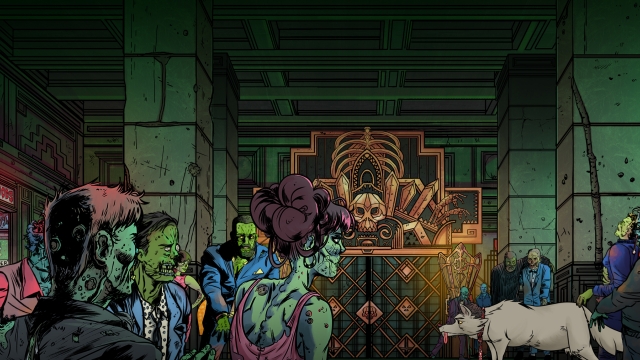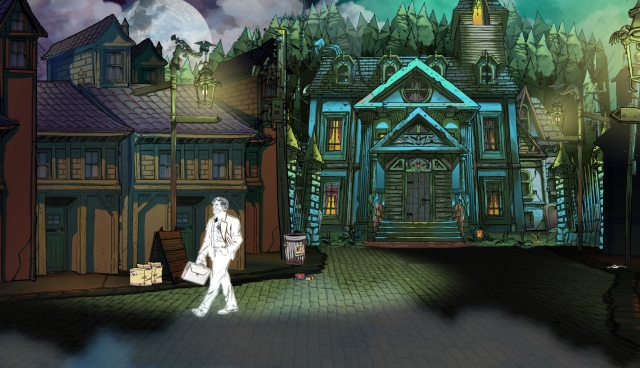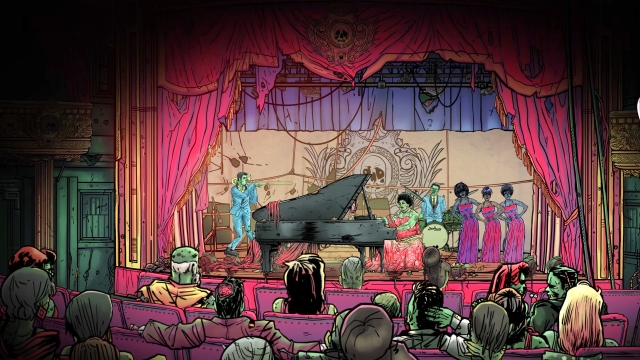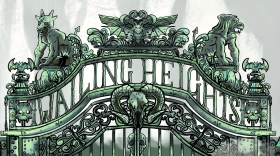
Wailing Heights Review
Towards the late ‘90s, before Telltale revolutionised the graphic adventure game genre, I used to play a game called Hollywood Monsters. It was one of the point-and-click games following the Full Throttle or Monkey Island formula, with equally abstruse puzzles and awkward lines. You were a reporter who found himself at a monster party, with guests like Dracula, a werewolf, and Dr. Fly. Almost twenty years later, the comedic juxtaposition of supernatural creatures in the most routine aspects of any person’s life still lends itself as an original tool to say something about people at large, or at least an attempt to. Wailing Heights uses the tropes that we’ve come to know and love to create funny situations out of ordinary ones. And I mean ‘funny’ from a very conceptual standpoint, as they don’t really make you laugh. You silently acknowledge that the idea is funny, and move on to the next cryptic puzzle, expecting a never-coming pace-up in the plot.
This is not to say that Wailing Heights’ humour is not good; it´s simply too tenuous and contingent on the theme of the game. It’s rarely enfranchised enough from this to be funny on its own — let’s take zombies. Zombies mutter incoherent grunts and sluggishly groan ‘Braaaiiins!’ when you approach to talk to them. However, when you are a zombie, you find that they have fairly interesting conversations with each other, only sounding incomprehensive to non-zombies. It’s the rest of creatures that do the groaning to a zombie’s ears. It’s funny, yes, but only conceptually. It lacks the ability to prompt uncontainable laughter from the audience, as the jokes are not snappy enough, just relentlessly sitting in the background. The issue is not with these jokes, but the lack of a mildly engaging story combined with an absence of ‘funny’ quips, in the most immediate sense of the word, makes for a lethargically-driven narrative.
 You are Finklestein, the manager and songwriter for The Deadbeats, only the most acclaimed rock band in Britain. Sadly, the members disbanded long ago, and Finklestein gloomily clings to the remains of the band’s popularity, while the others moved onto doom-bounded solo careers. You fortuitously end up arrested in Wailing Heights, a town inhabited by vampires, werewolves, ghosts and zombies alike, as wells as some other horrific creatures ambling about, well settled in their tertiary roles. On your quest to freedom, you are granted a possession wheel, an artefact that allows you to possess other people’s bodies as long as you know their name, something they love and something they hate. As you gallivant around town striving to manage your own freedom, your goals get thwarted by the sudden disappearance of your own body — while you were in other people’s bodies —, and the inspiring revelation that the four members of The Deadbeats are long deceased and now proud residents of Wailing Heights.
You are Finklestein, the manager and songwriter for The Deadbeats, only the most acclaimed rock band in Britain. Sadly, the members disbanded long ago, and Finklestein gloomily clings to the remains of the band’s popularity, while the others moved onto doom-bounded solo careers. You fortuitously end up arrested in Wailing Heights, a town inhabited by vampires, werewolves, ghosts and zombies alike, as wells as some other horrific creatures ambling about, well settled in their tertiary roles. On your quest to freedom, you are granted a possession wheel, an artefact that allows you to possess other people’s bodies as long as you know their name, something they love and something they hate. As you gallivant around town striving to manage your own freedom, your goals get thwarted by the sudden disappearance of your own body — while you were in other people’s bodies —, and the inspiring revelation that the four members of The Deadbeats are long deceased and now proud residents of Wailing Heights.
You probably can guess that music has a great role in this game. From the moment you boot it up, you will be merrily tapping your foot at the vibes of ‘We are The Deadbeats’, unarguably the catchiest and best-performed song in the game. This light rock song with funky and gospel vibes is only played twice in the game, and it’s just enough to get it stuck in your head for weeks. Most songs in the game balance the line between adroit and cheesy just perfectly, with a few notable exceptions. For every character that you possess, you will hear a five-second song. Throughout the whole game, you will be snapping back and forth from character to character, listening to their soundtrack each time you move into their body. Soul Ghoulman, the first character you meet and a ghost, is probably the character whose song you will hear the most, which will make you cringe every time you hear it. After the nth time you hear that melody, which is one of the less enjoyable ones, you will pull your hair every time you swap to that character. Generally, this extends to most of these 5-second pieces, being more noticeable in the ones with less quality.
 Much of what you’ll be doing in the game is wander about in search of particular objects to use in your possession wheel, and amplify the roster of playable characters until all members of the Deadbeats are on board. Every character will give you access to new areas or conversations with secondary characters, and with it, new melodies and beats to dance to. The story is not the game’s strength, and admittedly, you’ll sometimes find yourself drifting aimlessly with no idea where to go next, switching characters willy-nilly. Since you find each character scattered throughout Wailing Heights, it often can be annoying to go over the copious distances again and again. But the memorable personality of each is often reason enough to keep pushing. The stark contrast in the way other characters treat you depending on which character’s skin you’re wearing is ultimately a whimsical and light-hearted twist on urban tribes. Vampires, for example, are hipsters who wordlessly relish pretentiousness and harsh criticism, to the oxymoronic point that not liking something is a positive thing to say about it. With their addiction to phone screens and an introspective dependence on trends, they differ from the rambunctious werewolves, who love Irish folk music and base their relationships in primal alpha-beta interactions, and are scruffy enough to revel in a good bum sniff at the same time they pound their leg against the ground.
Much of what you’ll be doing in the game is wander about in search of particular objects to use in your possession wheel, and amplify the roster of playable characters until all members of the Deadbeats are on board. Every character will give you access to new areas or conversations with secondary characters, and with it, new melodies and beats to dance to. The story is not the game’s strength, and admittedly, you’ll sometimes find yourself drifting aimlessly with no idea where to go next, switching characters willy-nilly. Since you find each character scattered throughout Wailing Heights, it often can be annoying to go over the copious distances again and again. But the memorable personality of each is often reason enough to keep pushing. The stark contrast in the way other characters treat you depending on which character’s skin you’re wearing is ultimately a whimsical and light-hearted twist on urban tribes. Vampires, for example, are hipsters who wordlessly relish pretentiousness and harsh criticism, to the oxymoronic point that not liking something is a positive thing to say about it. With their addiction to phone screens and an introspective dependence on trends, they differ from the rambunctious werewolves, who love Irish folk music and base their relationships in primal alpha-beta interactions, and are scruffy enough to revel in a good bum sniff at the same time they pound their leg against the ground.
One thing I found commendable is the charismatic visual design of the game. Based on a comic style, it manages to depict the zombie hall as an accurate mix of decadence and elegant soul music. The combination of neon blues, greens and pinks gives the game a certain charm that does not diminish at any point. Perhaps an awkward aspect is the sound design, which combines great soundtrack with a few mediocre songs and lumbering voice acting. You often see through the cracks that the same actor was performing quite a few voices at a time, with a few occasional issues in lines not being played or crackling sound in the background. The visual side shows some lack of polish too, albeit less recurrently. Hardly game-breaking, and maybe this is all in a day’s work for such a small studio, but I felt compelled to mention it.
 The great quality of the soundtrack and the light-heartedness of the game is enough to lure you to the end of this four-hour game, but a final part that feels stale may tip the scale to the bad side of the spectrum. This game has genuinely good moments, but a lackadaisical core set of mechanics and a story compelling enough to make you dig under the surface may keep this game from not being as memorable as its visual style and music. One of the things that may have fixed this would have been a deeper back story about each member. You get the preliminary and mandatory exposition through a comic-like cutscene, but as you hum the soundtrack, you realise you still need some more to make them truly memorable.
The great quality of the soundtrack and the light-heartedness of the game is enough to lure you to the end of this four-hour game, but a final part that feels stale may tip the scale to the bad side of the spectrum. This game has genuinely good moments, but a lackadaisical core set of mechanics and a story compelling enough to make you dig under the surface may keep this game from not being as memorable as its visual style and music. One of the things that may have fixed this would have been a deeper back story about each member. You get the preliminary and mandatory exposition through a comic-like cutscene, but as you hum the soundtrack, you realise you still need some more to make them truly memorable.
Wailing Heights (Reviewed on Windows)
Game is enjoyable, outweighing the issues there may be.
Although this game just secretes good vibes, it's never funny or clever enough to pass the critical eye. However, its light-heartedness and character is enough to play it through, and will have you dancing to the beat of the game for its duration.











COMMENTS